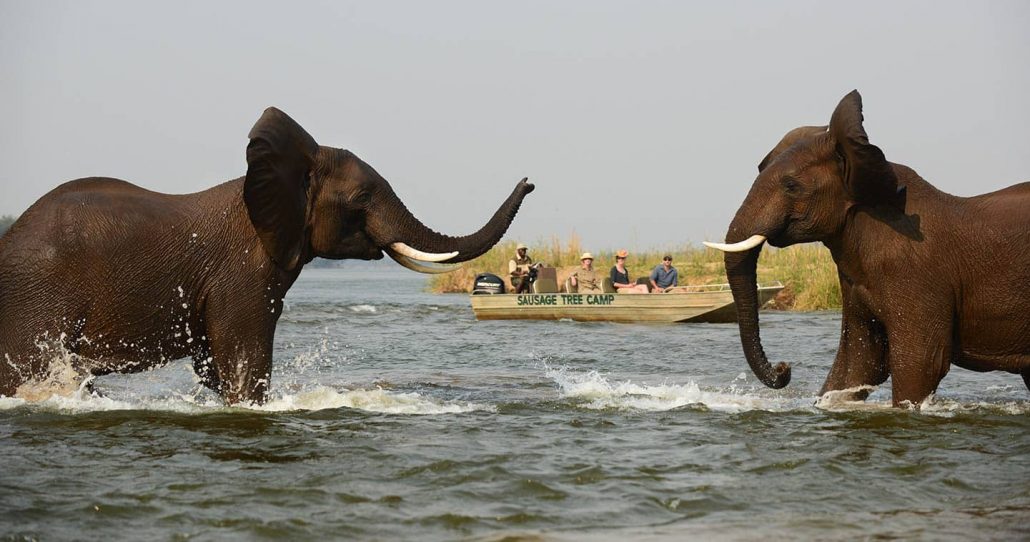Lower Zambezi National Park is Zambia’s newest Park and as such is still relatively undeveloped. It lies on the north bank of the Zambezi River in southeastern Zambia opposite the renowned Mana Pools National Park in Zimbabwe. Therefore, the entire area on both sides of the river is a massive wildlife sanctuary whose beauty lies in absolute wilderness. The Park covers an area of 4,092 sq km. Lower Zambezi Park is home to a myriad of wildlife including giant elephants and the hippopotamus. It offers some of the best game viewings in the world.

Lower Zambezi National Park
However, most of its game is concentrated along the valley floor. The diversity of animals is not as wide as the other big parks, but the opportunities to get close to game wandering in and out of the Zambezi channels are spectacular.
Vegetation
The Acacia albida trees a thorn species growing up10 – 30m in height with the classical shady umbrella canopy is the dominant plant cover in the area. It can ably bear the infertile sandier soils than other woodland species and serves to stabilize infertile sandbanks and reduce erosion. Available also is the winter thorn pods which is are also amazingly nutritious and good feed to the park elephants.
The Zambezi River
River Zambezi is the fourth largest river in Africa and a dominantly fascinating safari feature in the Park. It hails from a small brook at the upper Northwest corner of Zambia and flows through flows through six countries namely Angola, Namibia, Botswana, Zambia and Zimbabwe on its journey and empties into the Indian Ocean through a Delta at an amazing 2 700 km. River Zambezi has exceptionally violent rapids with no clear pattern of flow making it one of the world’s most difficult to negotiate, very fast and Unpredictable River to navigate.

The Zambezi River
Wildlife
Lower Zambezi National Park is best known for its herds of sable, but is also home to other antelope species, huge herds of elephant, waterbuck, zebra, leopard, giraffe, lion and buffalo. However, most of the game is concentrated along the valley floor. There was a great loss of the black rhinoceroses especially before the declaration of the Park as protected. There is an escarpment along the northern end which acts as a physical barrier to most of the parks animal species.
Birdlife
There are also a large number of species of birds. The birdlife along the riverbanks is more exceptional. Many a fish eagle can be seen and heard for miles around. Nesting along the cliffs are white-fronted and carmine bee-eaters. Another unusual the red-winged pratincole, the elegant crested guinea fowl, black eagle, and vast swarms of quelea. In summer the stunning Narina trogon makes its home here. Other specialties are the trumpeter hornbill, parrot and Lilian’s lovebird.
Getting There
Visitors on private game visits to Lower Zambezi National Park need a car, bicycles and motorbikes aren’t allowed except on the transit route to Kazungula. It is extremely discouraged to walk from Victoria Falls town to the park entrance gate.
Best time to visit
The best time to visit the Park is during the dry months from June to November. Temperatures bearably range from about 66 degrees to 86 degrees Fahrenheit. Tour the area with a walking and open-air vehicle safari. Better yet, explore by boat or canoe.

Canoeing in Lower Zambezi National Park
Where to Stay
There are various lodges to accommodate guests. The award-winning Chiawa Camp, for instance, is open from April through November and offers stunning views of the Zambezi, interesting and entertaining cultural activities, and professional, friendly staff. Royal Zambezi Lodge is another absolute luxury accommodation option with an abundance of wildlife, awesome sunrises over The Zambezi River, superb tiger fishing and excellent food. Available also are other riverside lodges at the park entrance each with two bedrooms, a living area, and a veranda, but they book up well in advance.
Activities
Wildlife enthusiasts safari to Zambia to experience as well as catch a glimpse into an untamed world the Lower Zambezi National Park. Several Zambia tours operators and safari guides organized tailored wildlife safaris into the park. The most popular are;
- Game Walks: Half / full day game walks are offered by available tours guides. There is also occasional overnight walks arranged.
- Horse riding: Horse back safaris accommodate up to eight riders at a time but children under 12 are only allowed if only they have had a year’s riding experience.
- Fishing: Fishing is good along the river with healthy tiger fish and bream catches being quite common as well as vundu, a member of the catfish family, weighing up to 50 kg.
- White water rafting on the Zambezi River.
- Day Game Drives: Game drivers in Lower Zambezi National Park are available. They are 3 hours activities beginning usually at 6 or 7am and finish between 9 and 11 am; and afternoon shifts which run from 3 to 6 pm.
- You can also go canoeing.





